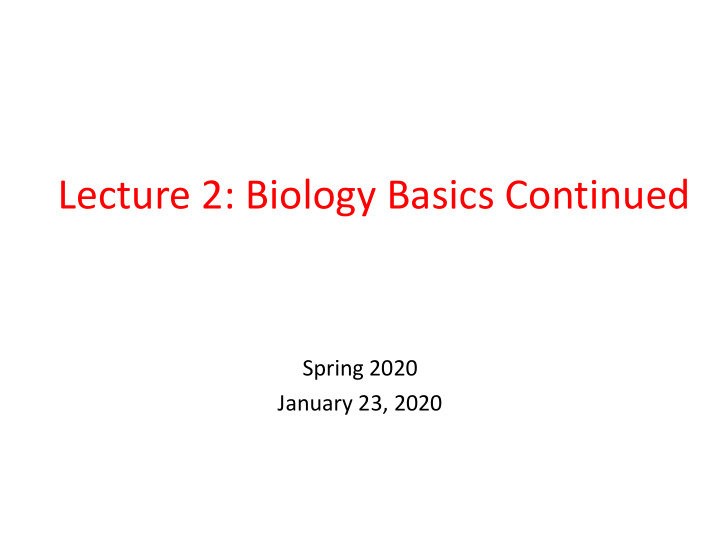



Lecture 2: Biology Basics Continued Spring 2020 January 23, 2020
Genetic Material for Life
Central Dogma
DNA: The Code of Life • The structure and the four genomic letters code for all living organisms • Adenine, Guanine, Thymine, and Cytosine which pair A-T and C-G on complimentary strands.
DNA: The Code of Life • DNA has a double helical structure which is composed of – sugar molecule – phosphate group – and a base (A,C,G,T) • DNA always reads from 5 ’ end to 3 ’ end for transcription and replication
DNA Replication • DNA can replicate by splitting, and rebuilding each strand. • Note that the rebuilding of each strand uses slightly different mechanisms due to the 5 ’ 3 ’ asymmetry, but each daughter strand is an exact replica of the original strand. http://users.rcn.com/jkimball.ma.ultranet/BiologyPages/D/DNAReplication.html
Reverse Complement of DNA What is the reverse complement sequence of TATAGCCCG?
Reverse Complement of DNA What is the reverse complement sequence of TATAGCCCG? CGGGCTATA
Central Dogma
Transcription and Post-transcriptional Modifications
DNA to Proteins Youtube video https://www.youtube.com/watch?v=D3fOXt4MrOM
Transcription Control • Regulatory regions: up to 50 kb upstream of +1 site • Exons: protein coding and untranslated regions (UTR) 1 to 178 exons per gene (mean 8.8) 8 bp to 17 kb per exon (mean 145 bp) • Introns: splice acceptor and donor sites, junk DNA average 1 kb – 50 kb per intron • Gene size: Largest – 2.4 Mb (Dystrophin). Mean – 27 kb.
Central Dogma
Naturally Occurring Amino Acids
Translation: Code Book of Life
Genes and Proteins • One gene encodes one protein and begins with start codon (e.g. ATG), then each three code one amino acid. Then a stop codon (e.g. TGA) signifies end of the gene. • In the middle of a (eukaryotic) gene, there are segments that are spliced out during transcription. – Introns: segments that are spliced out – Exons: segments that are kept. • Detecting the introns and exons is a task for gene finding.
Genotype/Phenotype • To prevent confusion between genes (which are inherited) and developmental outcomes (which are not), geneticists make a distinction between the genotype and the phenotype of an organism – Genotype : complete set of genes inherited by an individual – Phenotype : all aspects of the individual’s physiology, behavior, and ecological relationships
DNA the Genetics Makeup • Genes are inherited and are expressed • genotype (genetic makeup) • phenotype (physical expression ) On the left, is the eye’s phenotypes of green and black eye genes.
• Two organisms whose genes differ at one locus are said to have different genotypes. • A locus (loci for plural) is the specific location of a gene of a DNA sequence on a chromosome. • A variant of the DNA sequence at a given location is called an allele . • The ordered list of loci known for a particular genome is called a genetic map .
Diploid and polyploid cells whose chromosomes have the same allele of a given gene at some locus are called homozygous , with respect to that gene (otherwise, it is heterzygous ). The chromosomal locus of a gene might be written "6p21.3” • 6 : chromosome number • p : position on the chromosome’s short arm (“p”) or long arm (“q”) • 21.3 : the position on the arm: region 2, band 1, sub- band 3. The bands are visible under a microscope when the chromosome is stained.
Recommend
More recommend